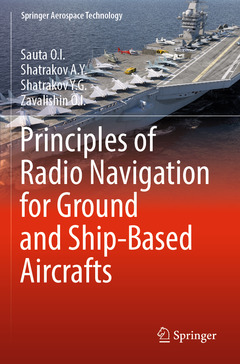Principles of Radio Navigation for Ground and Ship-Based Aircrafts, 1st ed. 2019 Springer Aerospace Technology Series
Auteurs : Sauta O.I. , Shatrakov A.Y. , Shatrakov Y.G. , Zavalishin O.I.

Introduction
Chapter 1. Basic principles of radio navigation
1.1 summary of radio navigation development
1.2 concept of navigation and radio navigation
1.3 coordinate systems
Chapter 2. The concept of radio navigation systems
2.1 features of radio waves propagation
2.2. Classification of radio navigation systems
2.3. Methods for determining the location of moving objects
2.4. System working area
2.5. Time keeping in radio navigation systems
Chapter 3. Short-range navigation systems
3.1. Short-range radio technical navigation system
3.2 TACAN radio navigation system3.3 radio navigation system vor/dme
3.4 gras automated system
Chapter 4. Systems of long-range radio navigation with ground-based stations
4.1 phase code systems of the long-wave range
4.2. Super-long wave range systems
Chapter 5. Instrumental landing systems
5.1 systems of one meter range
5.2 systems of the decimeter wave range5.3 microwave systems
Chapter 6. Satellite radionavigation systems
6.1 overview of the development of the systems
6.2 principles of system operations
6.3 main characteristics of systems
Chapter 7. Differential and relative operation modes of systems
7.1 principle of systems operation in differential mode
7.2 principle of operation in relative mode
Chapter 8. Augmentation systems to ground-based GNSS
8.1 principles of creation of satellite augmentation systems
8.2. General information on GBAS
8.3 purpose, basic requirements and functions of GBAS
8.4 technical requirements and characteristics of LAAS
8.5. The concept of system data integrity
8.6 characteristics of coordinates determination accuracy
8.7. Monitoring errors in ephemeris and GNSS failures
8.8 continuity of service
8.9. Selecting the channel and identifying the LAAS
8.10. Final approach path
8.11. Accounting of airport location conditions
8.12. Lateral and vertical thresholds of alarm actuation
8.13 monitoring and actions to keep the system in good operating condition8.14. Accuracy of setting reference parameters
8.15. Introduction of GBAS systems in Russia
Chapter 9 Automatic dependent surveillance
Reference
Dr. Sauta O.I. is an expert on air radio engineering systems for navigation and landing, and holds 20 patents for inventions in the field of radio engineering systems for satellite navigation.
Prof. Shatrakov A.Y. is the chair of radio engineering systems at the Institute of Radio Engineering, St. Petersburg State University. His chief research interests are in the area of radio navigation systems for air traffic control and safety.
Shatrakov Y.G., Professor, Doctor of Technical Sciences, Honored Science Worker of Russia, RATS full member, graduated from Leningrad Institute of Aviation Instrumentation and Leningrad University (Physics and Mathematics Faculty). He defended his thesis in 1966. He published more 400 monographs and textbooks on radio navigation, radiolocation, production organization. He prepared more than 100 candidates and doctors of science as a scientific adviser and scientific consultant. Scientific directions founded under the guidance of Y.G. Shatrakov are as follows: relative radio navigation; increased noise immunity of angle measuring systems due to suppression of correlation errors and interference; secondary radiolocation by individual numbers; reduction of labor intensity in the production of radio electronic products due to the introduction of flexible automated productions. He is the author including 30 patents for inventions in the field of radio technical systems; scientific supervisor of international projects for the creation of the MLS with Thomson-CSF (1980–1988), with US enterprises for the creation of joint LRNSs (long-range radio technical navigation systems) (Tropic-Loran) (1984), chief designer of on-board antenna-feed systems; founder of the correlation interference theory in aviation radio technical complexes and systems.
Zavalishin O.I. is an expert on the development and production of aeronautical equipment, land and aircraft equipment, land systems as a functional addition to global satellit
Highlights the basic principles of the construction and operation of radio navigating systems? (RNSs)
Presents practical solutions to problems arising in the operation and development of RNS systems
Discusses how RNSs substantially determine navigation accuracy and reliability, and in turn air safety
Date de parution : 08-2020
Ouvrage de 130 p.
15.5x23.5 cm
Disponible chez l'éditeur (délai d'approvisionnement : 15 jours).
Prix indicatif 89,66 €
Ajouter au panierDate de parution : 06-2019
Ouvrage de 130 p.
15.5x23.5 cm
Disponible chez l'éditeur (délai d'approvisionnement : 15 jours).
Prix indicatif 105,49 €
Ajouter au panierThèmes de Principles of Radio Navigation for Ground and Ship-Based... :
Mots-clés :
Short-range radio navigation; Radio waves propagation; GRAS automated system; Long-range radio navigation; Landing systems; Microwave systems; Satellite radionavigation; ground-based GNSS; Satellite augmentation systems; Functions of GBAS; GNSS failures; Local-Area Augmentation System (LAAS); Tactical Air Navigation System (TACAN)



